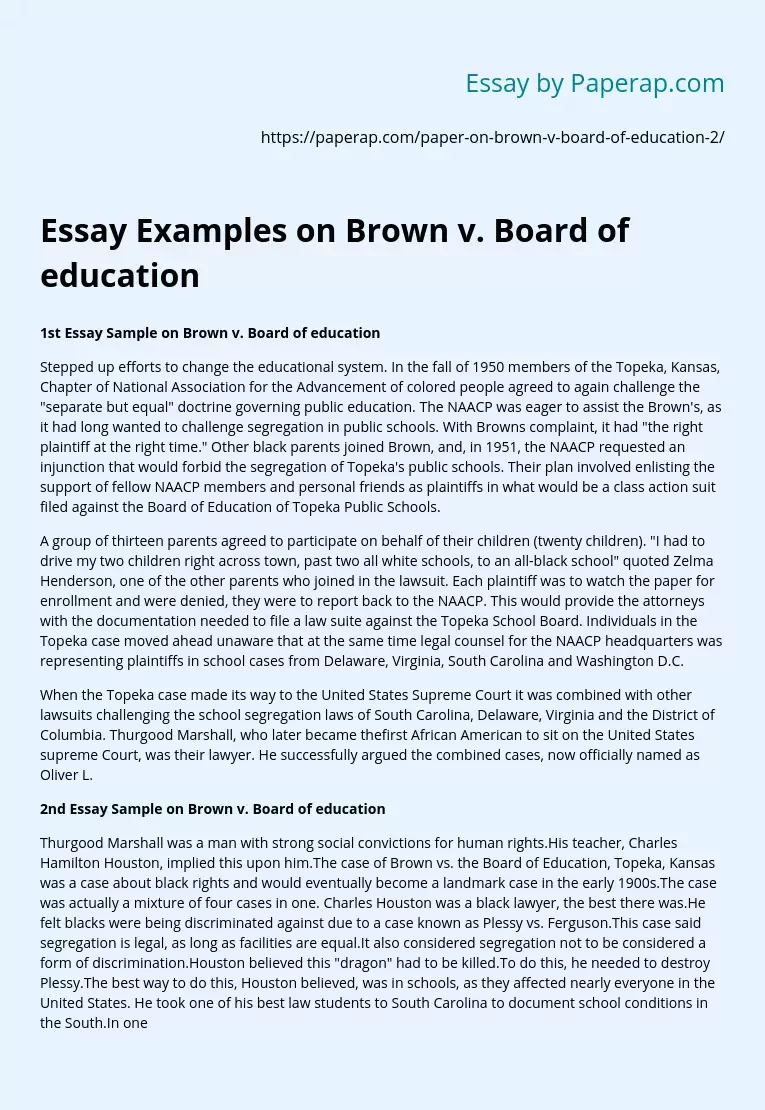Essay Examples on Brown v. Board of Education
Stepped up efforts to change the educational system. In the fall of 1950 members of the Topeka, Kansas, Chapter of National Association for the Advancement of colored people agreed to again challenge the “separate but equal” doctrine governing public education. The NAACP was eager to assist the Brown’s, as it had long wanted to challenge segregation in public schools. With Browns complaint, it had “the right plaintiff at the right time.” Other black parents joined Brown, and, in 1951, the NAACP requested an injunction that would forbid the segregation of Topeka’s public schools.
Their plan involved enlisting the support of fellow NAACP members and personal friends as plaintiffs in what would be a class action suit filed against the Board of Education of Topeka Public Schools.
A group of thirteen parents agreed to participate on behalf of their children (twenty children). “I had to drive my two children right across town, past two all white schools, to an all-black school” quoted Zelma Henderson, one of the other parents who joined in the lawsuit.
Each plaintiff was to watch the paper for enrollment and were denied, they were to report back to the NAACP. This would provide the attorneys with the documentation needed to file a law suite against the Topeka School Board. Individuals in the Topeka case moved ahead unaware that at the same time legal counsel for the NAACP headquarters was representing plaintiffs in school cases from Delaware, Virginia, South Carolina and Washington D.C.
When the Topeka case made its way to the United States Supreme Court it was combined with other lawsuits challenging the school segregation laws of South Carolina, Delaware, Virginia and the District of Columbia.
Thurgood Marshall, who later became thefirst African American to sit on the United States supreme Court, was their lawyer. He successfully argued the combined cases, now officially named as Oliver L.
Thurgood Marshall was a man with strong social convictions for human rights.His teacher, Charles Hamilton Houston, implied this upon him.The case of Brown vs. the Board of Education, Topeka, Kansas was a case about black rights and would eventually become a landmark case in the early 1900s. The case was actually a mixture of four cases in one. Charles Houston was a black lawyer, the best there was.He felt blacks were being discriminated against due to a case known as Plessy vs. Ferguson.This case said segregation is legal, as long as facilities are equal.It also considered segregation not to be considered a form of discrimination.Houston believed this “dragon” had to be killed.To do this, he needed to destroy Plessy.The best way to do this, Houston believed, was in schools, as they affected nearly everyone in the United States. He took one of his best law students to South Carolina to document school conditions in the South.In one county under the “separate but equal” ruling, a black elementary school’s facilities would not provide books for black students.They used old books thrown away by the white schools.The county wouldn’t provide anything to the school but the teacher’s salary.
In another school under the same ruling in Chester, South Carolina, there were 68 black students crammed into one room.There were ten books, no desks, and no equipment.The total amount of spending money given to the black school was $628.00 a year.In the white school of the same town, there were only 32 students to a room.They were also given $332,000 a year for spending money, plus equipment, desks, and books. Though there seemed to be enough evidence in elementary schools to start a court case, blacks were not willing to stand up for their rights or the rights of their children.Houston decided to start with cases in graduate law schools.
Essay Examples on Brown v. Board of Education. (2019, Oct 10). Retrieved from https://paperap.com/paper-on-brown-v-board-of-education-2/

